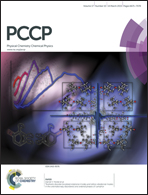Charge separation and isolation in strong water droplet impacts†
Abstract
Charge separation in condensed matter after strong impacts is a general and intriguing phenomenon in nature, which is often identified and described but not necessarily well understood in terms of a quantitative mechanistic picture. Here we show that charge separation naturally occurs if water droplets/clusters or ice particles with embedded charge carriers, e.g., ions, encounter a high energy impact with subsequent dispersion – even if the involved kinetic energy is significantly below the molecular ionization energy. We find that for low charge carrier concentrations (c < 0.01 mol L−1) a simple statistical Poisson model describes the charge distribution in the resulting molecular “fragments” or aggregates. At higher concentrations Coulomb interactions between the charge carriers become relevant, which we describe by a Monte Carlo approach. Our models are compared to experimental data for strong (laser) impacts on liquid micro beams and discussed for the charge generation in cluster-impact mass spectrometry on cosmic dust detectors where particle kinetic energies are below the plasma threshold. Taken together, a simple and intuitive but quantitative microscopic model is obtained, which may contribute to the understanding of a larger range of phenomena related to charge generation and separation in nature.


 Please wait while we load your content...
Please wait while we load your content...